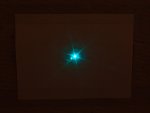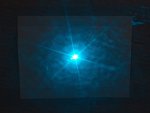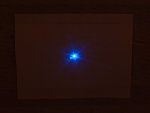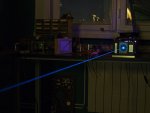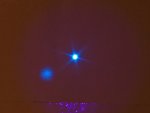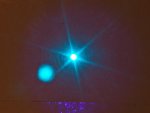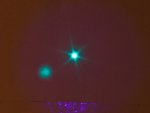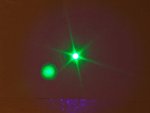One, its not an oxide cathode by any means.. Always Barium Dispenser. Oxide cathodes only last a few hours in ion laser service.
Your full answer is contained in Halsted, A Bridges, W Manufacturing Methods Program Five Watt Ion Laser, Volume One Which is probably a bit hard to get outside of the US. It's a US Air Force Document, on a muti-year research program which sped the Ion laser to commercial sale.
What is not readily appearent to the naked eye is a ion sheath formed just past the cathode dark space in the plasma. A 3 volt AC field is enough to move it around, but a DC field pulls it to one side and into contact, causing energetic, localized Ion bombardment. That selectively etches the cathode near the joint to the feedthru lead.
Generally cathode lifetime with a DC field is a few tens of hours before serious erosion starts. Failure is typically within 50-80 hours of operation on DC.
Which is why the low noise lasers operate their cathode on DC with the field flipped about ten times per second to even the wear.
There have been very few of them made, the reduced lifetime means that the factory warrenty is frequently used by the customer.
I received a phone call a few years ago from an instrument manufacturer who wanted rid of 50 and 60 Hertz amplitude noise in their semiconductor wafer mapping instruments, every cathode they ran on DC died within 24 hours.
JDSU then contacted me, and were getting less then a week on the 24 tubes they placed on DC cathode life test. For essentially the same reason, reduction of amplitude noise.
I know of another manufacturer who redesigned the bore to cathode distance to eliminate the effect by changing the dark space distance. However it really lengthened the tube, which is not the case with the NEC, and I used to have quite a few NECs.
The DC erosion starts at one end, and typically occurs just past where the nickel or molybednum plate or tube is tig welded between the tungsten lead and the braze to the Kovar lead. This is the weakest point of the cathode structure. The intermediate metal is there because typical braze and lead materials alloy with the tungsten and mechanically weaken it, when hot.
In the first two cases, I sited Bridges and Halstead, and told them to test for a reversal rate that stopped the erosion. The third party was well aware of the problem and had an alternative solution to it, but still at a greatly reduced lifetime and increeased tube length.
If I have time to scan in Bridges and Halsted, I'll do so, but suffice it to say, heed my warning for now. This has been a known problem since the invention of the ion laser.
There is no reason to soft start the cathode, in fact we avoid it, as the tungsten core has a well known soft phase at about 700' C during warmup. Sagging or shorted turn cathodes are typically caused by two reasons, a low tube fill pressure causing localized plasma heating, and/or a misadjusted cathode transformer where the cathode is too cold.
Some larger lasers do run constant wattage AC transformers, but even those surge the cathode till it self stabilizes at operating temperature. Lasers that do not have ferroresonant transformers, have tapped transformers for the cathode, set by the installation
engineer. The factory produces a tap chart for each model.
A few JDSU models have switching power supplies for the cathodes that supply high frequency AC. It reduces the weight of the PSU.
Laser cathodes are ran cold, typically ~1150 Deg K..., orange hot to barely white hot.
Its been about five years since I've had to explain all this, so my explation may be a bit rusty.
The plasma sheath interaction is complex, I can guage the health and gas pressure of a tube by how the delta in the cathode heating current behaves when the plasma starts, and transitions to a stable arc... Removing electrons properly cools the cathode, so we see a positive delta in a healthy tube. Ion bombardment from improper pressure does the opposite. A middle of life tube shows low or no delta.
The effect is so pronounced, that factory tube test sheets , show plasma on, and plasma off cathode tests.
Gas is driven into the tube walls during operation. If everything is perfect, your NEC would become hard starting from low gas pressure at end of life. The cathode would then fail from ion bombardment, and loose its emissive surface.
The huge NEC end bell is there as a gas resivoir to stabilize the pressure for long life.. A larger laser would have a seperate tank attached, or has a solenoid valve system for gas fill.
DC operation would be desirable, but with a few tiny exceptions, all mass produced ion lasers have balanced, ac cathodes, with the DC current fed to the center tap of the cathode transformer.
Please heed my warning, but it would be three or four days before I can scan you the document you would wish to see.
Steve




